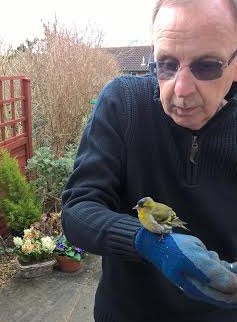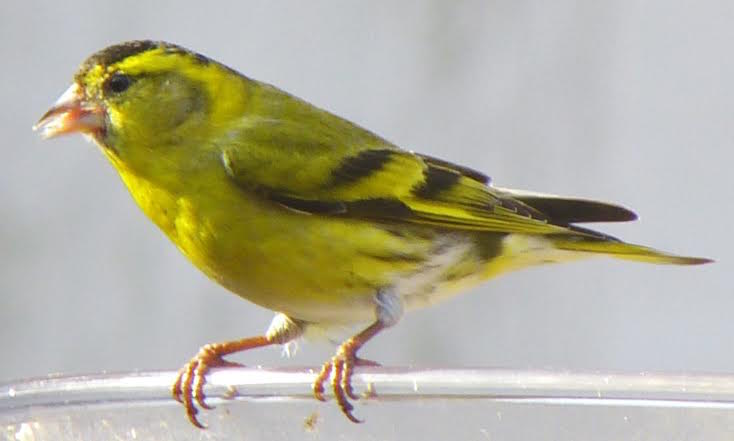 Abraham Lincoln
If given the truth, the people can be depended upon to meet any national crisis...
Abraham Lincoln
If given the truth, the people can be depended upon to meet any national crisis...
 Guildford news...
for Guildford people, brought to you by Guildford reporters - Guildford's own news service
Guildford news...
for Guildford people, brought to you by Guildford reporters - Guildford's own news service
An Unfortunate Injury Offers A Rare Close Up View Of A Lesser Known Bird
Published on: 18 Mar, 2016
Updated on: 19 Mar, 2016

This injured siskin who was reluctant to leave my hand and garden in Merrow. Pleased to say it revived and eventually flew writes Dragon reader Colin Mills.
By Malcolm Fincham
A photo submitted by Guildford Dragon readers Colin and Joan Mills has prompted me to write about one of our less mentioned birds, the siskin.
Although frequently mistaken for greenfinches, siskins, one of smallest of the finch family, are unmistakable when seen at close quarters.
They have an unusual migration pattern, being are irruptive in their nature, moving in flocks to find food.
They breed mainly in the north of the UK in coniferous woodland, where they feed mostly on fir cone seeds. One of its favourite is the non native Sitka Spruce named after a place called Sitka in Alaska.
Every few years in winter they migrate southwards in large numbers, when food sources dry up. Although a few are known to breed in the southern counties, the best opportunity to see them in Surrey is during winter months. They seem to favour seed cones of the alder tree.
These trees are abundant along parts of the River Wey, so its always worth checking them for flocks of agile birds, feeding upside-down, high in the canopy.
When times get tough, they often depend on human assistance by arriving at feeding stations. This can offer the real treat of seeing them close up.
Identification tips: The siskin is a small, lively finch, smaller than a greenfinch. It has a distinctly forked tail and a long narrow bill. The male has a streaky yellow-green body and a black crown and bib. There are yellow patches in the wings and tail. Flashes of yellow can erupt as they take flight, flutter at branch tips, or display during mating.
Do you have any photos you would like to share of local fauna? If so, please send to guildford.dragon@gmail.com.
Recent Articles
- Notice: Dennisville Community Afternoon – May 18
- ‘Devolution’: ‘We Are Like Ants Considering How the Lawn Is Going To Be Cut’
- Guildford MP Attends Local Action Day Organised by ZERO Carbon Guildford
- New Outreach Service to Support Women Affected by Gambling
- Letter: I Suspect the Vast Majority Really Don’t Care About This Nonsense
- Opinion: It’s the Debt Stupid!
- Updated: Teenager Dies in Guildford Collision
- Council Reorganisation: Proposals ‘Will Not Make a Jot of Difference’ Says Councillor
- Letter: See How the Bluebells Have Been Damaged
- Ash Vale Residents Call For Firm Action To Stop Catapult Attacks on Canal Wildlife


Search in Site
Media Gallery
Dragon Interview: Local Artist Leaves Her Mark At One of England’s Most Historic Buildings
January 21, 2023 / No Comment / Read MoreDragon Interview: Lib Dem Planning Chair: ‘Current Policy Doesn’t Work for Local People’
January 19, 2023 / No Comment / Read MoreA3 Tunnel in Guildford ‘Necessary’ for New Homes, Says Guildford’s MP
January 10, 2023 / No Comment / Read More‘Madness’ for London Road Scheme to Go Ahead Against ‘Huge Opposition’, Says SCC Leader
January 6, 2023 / No Comment / Read MoreCouncillor’s Son Starts Campaign for More Consultation on North Street Plan
December 30, 2022 / No Comment / Read MoreCounty Council Climbs Down Over London Road Works – Further ‘Engagement’ Period Announced
December 14, 2022 / No Comment / Read MoreDragon Interview: GBC Reaction to the Government’s Expected Decision to Relax Housing Targets
December 7, 2022 / No Comment / Read MoreHow Can Our Town Centre Businesses Recover? Watch the Shop Front Debate
May 18, 2020 / No Comment / Read More












Recent Comments